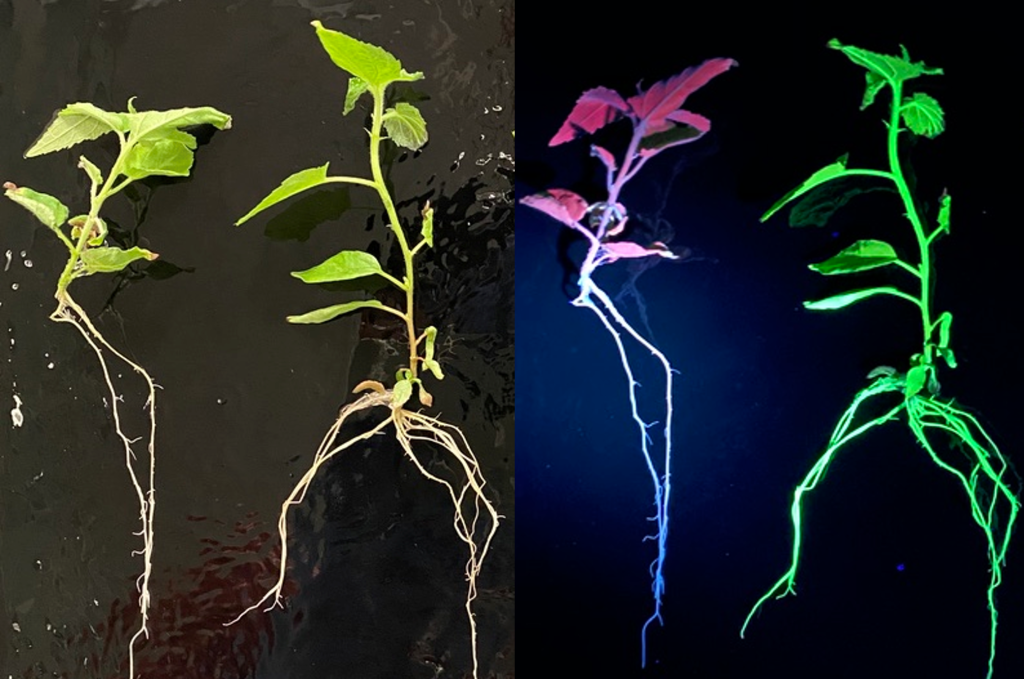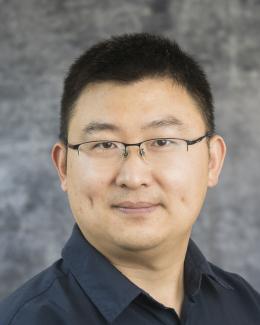Detecting the activity of CRISPR gene editing tools in organisms with the naked eye and an ultraviolet flashlight is now possible using technology developed at the Department of Energy’s Oak Ridge National Laboratory.
Scientists demonstrated these real-time detection tools in plants and anticipate their use in animals, bacteria and fungi with diverse applications for biotechnology, biosecurity, bioenergy and agriculture. The team described the successful development of the UV system in Horticulture Research and their proof-of-principle demonstration in ACS Synthetic Biology.
CRISPR technologies have quickly become the primary tools of bioengineering, and new versions are continually in development. Identifying whether an organism has been modified by CRISPR technology was previously a complex and time-consuming process.
“Before this, the only way to tell if genome engineering occurred was to do a forensic analysis,” said Paul Abraham, a bioanalytical chemist and head of ORNL’s Secure Ecosystem Engineering and Design Science Focus Area. “To be successful, you would need to know what the genome looked like before it was rewritten. We wanted to design a platform where we could proactively observe CRISPR activity.”
The research team developed an efficient self-detect solution that takes advantage of the way CRISPR works to trigger the technology to reveal itself. Under normal conditions, CRISPR works by connecting with a short RNA sequence, known as the guide RNA, as it leads CRISPR to a matching DNA sequence. When the target DNA is found, CRISPR modifies the DNA by acting like tiny molecular scissors to cut through one or both strands of DNA, depending on the type of CRISPR technology in use.
Abraham likens their method to an alarm system with two components: a biosensor guide RNA that redirects CRISPR activity and a reporter protein that flags the activity. Researchers encode the two components into an organism’s DNA to enable the monitoring system.
With the self-detect system in place, the biosensor guide RNA intercepts CRISPR, preventing CRISPR from connecting with its original gene target and redirecting CRISPR to a specific DNA sequence that encodes for a nonfunctioning green fluorescent protein, or GFP. When CRISPR edits the sequence, it flips a switch that produces functioning GFP, which creates a green glow signaling CRISPR’s presence.
Because a microscope is required to see the glow from GFP, the researchers improved on their original method by replacing GFP with a similar reporter protein, called eYGFPuv, that is visible under the type of ultraviolet light commonly known as a black light.

“Now we can see whether CRISPR is active in real time regardless of the size, shape and location of the organisms we’re evaluating,” Abraham said. “This flexibility speeds the bioengineering process and extends the biosensors’ use in laboratory and field applications.”
Since CRISPR must be tailored to each organism for effective use, knowing whether the CRISPR technology is working in a particular plant or microbe can accelerate progress toward goals such as developing drought-resistant bioenergy crops and engineering bacteria to efficiently convert plants into sustainable aviation fuels.
“These tools allow us to quickly identify positive transformants with desired genetic changes we are targeting,” said Carrie Eckert, lead for ORNL’s Synthetic Biology Group. “We are easily able to see the variants versus those where modification did not occur.”
The biosensors also provide an effective method to know whether CRISPR is still active after the desired modifications have taken effect. ORNL plant synthetic biologist and co-author Xiaohan Yang compares CRISPR’s genome editing activity to a beneficial surgery but cautions that “you don’t want the surgeon to leave the scissors behind” as continued CRISPR activity could have unintended effects.
Yang envisions biosensor applications that could test the progeny of modified plants, for instance, to verify that the gene editing machinery did not transfer to them. With this technology, it is possible to survey an entire field of crops.
The research team created specific biosensors to detect various CRISPR tools, including Cas9 nuclease, prime editor, base editor and CRISPRa. They demonstrated the sensors individually with each sensor signaling the presence of a particular type of CRISPR tool. Abraham also sees the potential to combine the biosensors into a version that would flag multiple gene editing technologies at once.
“We’ll continue to optimize these biosensors to improve the security of next-generation biotechnologies,” Abraham said.
Contributors to the paper titled “Expanding the application of a UV-visible reporter for transient gene expressions and stable transformation in plants” include ORNL’s Guoliang Yuan, Haiwei Lu, Md. Mahmudul Hassan, Jin-Gui Chen, Gerald Tuskan and Xiaohan Yang, as well as Dan Tang and Yi Li of the University of Connecticut.
The scientists detailed their proof-of-principle demonstration in ACS Synthetic Biology. Co-authors on the paper, “Plant-based biosensors for detecting CRISPR-mediated genome editing,” include ORNL’s Guoliang Yuan, Md. Mahmudul Hassan, Tao Yao, Haiwei Lu, Michael Vergara, Wellington Muchero, Jin-Gui Chen, Gerald Tuskan, Paul Abraham, Xiaohan Yang and Jesse Labbe (now at Invaio Sciences), as well as Changtian Pan and Yiping Qi of the University of Maryland.
The research was supported by the Center for Bioenergy Innovation and the Secure Ecosystem Engineering and Design Science Focus Area, which are both funded by the Biological and Environmental Research program in DOE’s Office of Science. Additional support was provided by the National Science Foundation.
UT-Battelle manages ORNL for the Department of Energy’s Office of Science, the single largest supporter of basic research in the physical sciences in the United States. The Office of Science is working to address some of the most pressing challenges of our time. For more information, please visit energy.gov/science.






